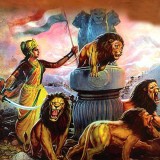[box_light]Asana is the aspect of Yoga least detailed in older Vedic and Yogic texts and is the aspect of classical Yoga given least importance overall. Sometimes little more about asana is said in the older texts than the need to sit straight ( Bhagavad Gita and Upanishads), or to maintain a comfortable pose (Yoga Sutras).[/box_light]
 This has led some people to think that the active asana approaches and movements, such as practiced by many modern Yoga groups, were not part of the older Yoga traditions or were not known in India. It has also gotten some to hold that active or strong exercise methods, like calisthenics type movements, only entered India recently through Europe and were previously unknown, with Yoga asanas being the main form of exercise taught in India. This plays into cultural stereotypes that Indians are physically weak and the Europeans physically strong – a view that arguably borders on racism.
This has led some people to think that the active asana approaches and movements, such as practiced by many modern Yoga groups, were not part of the older Yoga traditions or were not known in India. It has also gotten some to hold that active or strong exercise methods, like calisthenics type movements, only entered India recently through Europe and were previously unknown, with Yoga asanas being the main form of exercise taught in India. This plays into cultural stereotypes that Indians are physically weak and the Europeans physically strong – a view that arguably borders on racism.
To adequately approach this issue, we must first examine the greater exercise traditions of India, including Vedic martial arts, and not limit ourselves to yogic texts. We must also understand how Yoga asana and exercise in general relate, their similarities and differences, and their respective places in Indian culture.
Yoga was never primarily an exercise tradition and we cannot look to yogic texts for understanding the exercise traditions of India. Dhanur Veda or the Vedic martial arts is the main basis and oldest form of exercise tradition of India and one that has continued to develop over time.
Yoga and Dhanur Veda overlap to some degree, but more active forms of exercise connect primarily with Dhanur Veda and only secondarily with Yoga.
[box_light]Asana and Exercise Traditions: Related but Different[/box_light]
 There has been a tendency to look at asana or yoga postures as the main exercise system practiced historically in India, with any more active exercise approach like calisthenics and weight lifting, being perhaps a recent borrowing from the West, or even something not particularly Indian, with Indians being more mental than physical types. This plays into stereotypes of India as not having strong martial or military traditions, some arising from the recent emphasis on Gandhi ahimsa in the country. Several scholars of modern Yoga have proposed something of this kind. A deeper examination, however, finds this view to be inaccurate or incomplete.
There has been a tendency to look at asana or yoga postures as the main exercise system practiced historically in India, with any more active exercise approach like calisthenics and weight lifting, being perhaps a recent borrowing from the West, or even something not particularly Indian, with Indians being more mental than physical types. This plays into stereotypes of India as not having strong martial or military traditions, some arising from the recent emphasis on Gandhi ahimsa in the country. Several scholars of modern Yoga have proposed something of this kind. A deeper examination, however, finds this view to be inaccurate or incomplete.
First of all, Yoga asana, as part of classical Yoga traditions like the Yoga Sutras, was never meant as a merely an exercise or fitness system.
Asana in Sanskrit means a chair or a seat, and in terms of bodily positions implies a seated pose, and by extension any pose assumed or held for an extended period of time.Asana in classical Yoga was not meant as simply a type of physical exercise, which is called vyayama in Sanskrit, but as part of Yoga practice, called Sadhana, a spiritual discipline resting upon the ability to sit or be still for long periods of time for the practice of meditation. Traditional Yoga asana was not meant as a workout or fitness drill. However, we must recognize that other exercise traditions did exist in India, besides Yoga asanas, which were more active in nature, and sometimes did use asanas and vinyasas along with other stronger exercise practices.
 Yoga asana could be used as part of other Indian exercise approaches, sometimes serving a role like preliminary warm ups or stretches. In these cases, case such asana practice was not regarded as Yoga, which means a spiritual path in Sanskrit, but as a means of bodily health and strength. In other words, asana as exercise did exist in ancient India but as a different orientation from asana as classical Yoga, which was a tool to still the body for meditation, not meant as a physical workout.The use of asana in exercise approaches should be discriminated from its role in meditation approaches, though some natural overlap exists.
Yoga asana could be used as part of other Indian exercise approaches, sometimes serving a role like preliminary warm ups or stretches. In these cases, case such asana practice was not regarded as Yoga, which means a spiritual path in Sanskrit, but as a means of bodily health and strength. In other words, asana as exercise did exist in ancient India but as a different orientation from asana as classical Yoga, which was a tool to still the body for meditation, not meant as a physical workout.The use of asana in exercise approaches should be discriminated from its role in meditation approaches, though some natural overlap exists.
India as a vast subcontinent and great ancient civilization has its own ancient and diverse traditions of exercise, martial arts, gymnastics and dance that cover the full range of exercise practices, including every sort of callisthenics. India did not require the Europeans in order to bring the idea of physical fitness or exercise into the region. The same situation existed in China and the rest of Asia that also had slower or more internalizing forms of exercise like Yoga or Tai Chi, which did not mean that they did not also have stronger exercise approaches as well. India has its own long traditions of martial arts.
[box_light]Martial Arts and Indian Exercise Traditions[/box_light]
 India has a great heritage of its Kshatriya, its martial, military, aristocratic or princely class, just as most of the world had until recent times. It is among these traditional martial arts that we can find the most diverse and extensive traditions of exercise. Even the Vedas speak of the unity of Brahmin and Kshatriya or spiritual and warrior traditions and the need to honor both.[ Hindu warrior traditions continued through history and developed along with changes of warfare through the centuries.
India has a great heritage of its Kshatriya, its martial, military, aristocratic or princely class, just as most of the world had until recent times. It is among these traditional martial arts that we can find the most diverse and extensive traditions of exercise. Even the Vedas speak of the unity of Brahmin and Kshatriya or spiritual and warrior traditions and the need to honor both.[ Hindu warrior traditions continued through history and developed along with changes of warfare through the centuries.
The Vedas have a special tradition of martial arts called Dhanur Veda, which is one of the four Upavedas or secondary Vedas. Such Vedic martial arts like Kalari remain popular in South India to the present day, though many others have probably been lost in the course of time. Dhanur literally means a bow, so archery was one of these martial arts. Yet India has had a long tradition of sword fighting as another martial art.
The most famous ancient guru of the martial arts or Dhanur Veda, who is found in the Ramayana as well teaching the martial arts to Rama and Lakshman, is the rishi Vishvamitra, a famous Rajarshi or royal sage, combining both Kshatriya and Brahmin lines. Vishvamitra is the seer of the third of the ten books of the Rigveda and of the famous Gayatri mantra, the most widely used Vedic mantras for all the Hindus.
 Hindu history and stories like the Puranas laud many ancient warriors and kings, along with their great victories, a number as chakravartins, meaning world-conquerors or universal rulers. The Vedas themselves contains many verses in praise of ancient kings and their martial exploits, like Trasadasyu, with some Vedic hymns composed by royal sages like Sudas or Mandhata. Great warriors like Arjuna or Rama had special weapons or astras created through the use of mantra and meditation, and harnessing the forces of nature. This martial aspect was always there with the different Hindu, Buddhist and Jain dynasties in the region.
Hindu history and stories like the Puranas laud many ancient warriors and kings, along with their great victories, a number as chakravartins, meaning world-conquerors or universal rulers. The Vedas themselves contains many verses in praise of ancient kings and their martial exploits, like Trasadasyu, with some Vedic hymns composed by royal sages like Sudas or Mandhata. Great warriors like Arjuna or Rama had special weapons or astras created through the use of mantra and meditation, and harnessing the forces of nature. This martial aspect was always there with the different Hindu, Buddhist and Jain dynasties in the region.
Martial arts are well known in Buddhist monastic traditions of China and Japan. These are attributed an Indian origin to Bodhidharma, who came from the famous city of Kanchipuram, not far from modern Chennai. Bodhidharma was said to have brought both Zen and Martial arts to China.
Hindu monastic and sadhu traditions are well known for their martial lines, like the famous Naga sadhus who wield tridents or Trishulas to the present day, leading the marches of monks for the great Kumbha Mela gatherings. A Hindu monastic order today is called an akhada, which also means a gymnasium (much like the Greek Academy). The monastic orders have asanas, exercises and martial arts, in part to keep the monks active and physically fit.
Many Hindu monastic orders over the past thousand years were formed to help protect Hindu society from the attacks of Islamic armies and had such martial sides.
 The Indian warrior class also used mantras and called upon deities for success in battle, like the famous battle cry “Jai Sri Ram”, that is still the war cry of the Indian army of the state of Uttar Pradesh.
The Indian warrior class also used mantras and called upon deities for success in battle, like the famous battle cry “Jai Sri Ram”, that is still the war cry of the Indian army of the state of Uttar Pradesh.
The Goddess Durga was said to have given the royal sword to the kings, including such figures as Sivaji of Maharashtra.The colonial British army owed its prowess to its Gurkha soldiers from Nepal. Gurkhas mainly worship the Goddesses Kali and Durga, Hindu martial Goddesses, and claim connection to Gorakhnath, the main Nath Yogi behind Siddha Yoga and Hatha Yoga traditions. Their war cry is “Jai Ma Kali, Here Come the Gurukhas.” Hatha Yoga itself arose as part of a martial and monastic approach to Yoga. Hatha itself means force in Sanskrit.
[box_light]Weight Lifting, Weapon Lifting and Physical Development[/box_light]
 Indian martial arts training involved the use of heavy weapons including swords and the mace (gada). Bhima, one of the five Pandavas and companions of Lord Krishna, was famous for his use of the mace and defeated Duryodhana in a mace fight. Hanuman also was famous for his mace. Such heavy weapon training served like weight lifting to build the muscles.
Indian martial arts training involved the use of heavy weapons including swords and the mace (gada). Bhima, one of the five Pandavas and companions of Lord Krishna, was famous for his use of the mace and defeated Duryodhana in a mace fight. Hanuman also was famous for his mace. Such heavy weapon training served like weight lifting to build the muscles.
Even the use of the bow, particularly the long bow that we find in India depictions like that of the Ramayana, requires a lot of muscular strength in order to use. Rama’s story was that only he could string the bow of Lord Shiva as it was so difficult that no other warrior could do so.
All the other princes tried and failed. Rama gained Sita as a wife as his reward for stringing the bow. Rama was well known for his expertise at archery.
 India has extensive traditions of wrestling. In fact Lord Krishna was regarded as a great wrestler and was thought to have defeated his enemy Kamsa in a wrestling match. Such wrestling traditions employed different exercise approaches than Yoga and much like wrestling from throughout the world.
India has extensive traditions of wrestling. In fact Lord Krishna was regarded as a great wrestler and was thought to have defeated his enemy Kamsa in a wrestling match. Such wrestling traditions employed different exercise approaches than Yoga and much like wrestling from throughout the world.
India has a long tradition of depiction of athletes, warrior and muscle men, as does most of the cultures of the world. The great avatar and emperor Lord Rama is the forest of these, portrayed with his long bow and a strong physique. Hanuman, his monkey companion, is a kind of Indian superman, noted for his muscular strength and miraculous powers. Bhima, the strongest warrior in the Mahabharata, is another. Another is Parashurama, who precedes Rama as an avatar of Lord Vishnu, who wielded an axe to conquer the deviant Kshatriyas or adharmic and unrighteous kings.
Modern Hindu Yogis were not all emaciated ascetics and many developed great physical strength. Even the forms of Hindu deities like Shiva are not portrayed weak in form or stature, but as physically strong. In addition, the typical Himalayan Hindu Sadhu lives in a cold mountain climate, with little food and clothing, developing an ability to adjust to the elements, relying on physical strength and endurance.
[box_light]Gymnastics of India and the Gypsies[/box_light]
 India has had a long tradition of gymnastics as well. This is best revealed by the circuses in India, which remain popular today, and have a great antiquity.
India has had a long tradition of gymnastics as well. This is best revealed by the circuses in India, which remain popular today, and have a great antiquity.
The gypsies, who originated in India, brought these gymnastic traditions to the Europe, along with their circuses.
There were whole castes or communities who kept up such traditions of physical prowess and dexterity and are still found in India today.There were entire classes of such circuses and entertainers in ancient texts called Sutas and Magadhas, mentioned as early as the Manu Smriti, the main ancient Hindu law code.
[box_light]Indian Dance[/box_light]
 India has many traditions of classical dance like Kathak, Bharat Natyam, Odissi, and Kathakali. Each region of India has its own type of dance. These require strength and include gymnastic movements of various types. Asanas are used by Indian dancers to gain great flexibility, which is an old tradition.
India has many traditions of classical dance like Kathak, Bharat Natyam, Odissi, and Kathakali. Each region of India has its own type of dance. These require strength and include gymnastic movements of various types. Asanas are used by Indian dancers to gain great flexibility, which is an old tradition.
Shiva who is the Lord of Dance is also the Lord of Yoga and the Lord of Asana in Hindu thought. The 108 dance poses of Lord Shiva include many movements and vinyasas. The cross over between classical Indian dance and Yoga is quite extensive historically and extends to the present day in which dancers practice various asanas to help gain greater flexibility.
[box_light]Older Vedic Origins [/box_light]
 We find ancient Indus or Harappan seals with figures in various Yoga postures, sitting and stretching. The Vedas themselves reflect traditions of martial art and dance. Many Vedic deities have warrior characteristics and are portrayed as possessing great strength and energy including Indra, Agni and Soma. Indra and Rudra among the Vedic deities are also referred to as dancers. Rudra, who is later connected with Lord Shiva, is also a famous archer in Vedic texts, bringing in the Dhanur Veda connection.
We find ancient Indus or Harappan seals with figures in various Yoga postures, sitting and stretching. The Vedas themselves reflect traditions of martial art and dance. Many Vedic deities have warrior characteristics and are portrayed as possessing great strength and energy including Indra, Agni and Soma. Indra and Rudra among the Vedic deities are also referred to as dancers. Rudra, who is later connected with Lord Shiva, is also a famous archer in Vedic texts, bringing in the Dhanur Veda connection.
The Mahabharata, India’s great epic, abounds with stories of great warriors and their magical powers, combining martial arts like archery with yogic tools like mantra and meditation, like the case of Arjuna, Krishna’s companion. The same is true of the Ramayana, the most famous epic of South Asia.
Rama performs a series of mantras to the Sun God to enable him to defeat Ravana in battle. Hanuman was well known for his yogic and martial prowess. We can therefore speak of a long history of ‘martial Yoga traditions’, which have included a variety of active exercise traditions as well.
[box_light]Conclusion[/box_light]
 Callisthenic traditions tend to be alike worldwide because they are working with the same human body and its normal range of movements. Similarities in such approaches between India and the West does not prove that India had no exercise traditions before the modern period. It is part of the prejudice that portrays Indians as physically weak and the Europeans as physically strong.
Callisthenic traditions tend to be alike worldwide because they are working with the same human body and its normal range of movements. Similarities in such approaches between India and the West does not prove that India had no exercise traditions before the modern period. It is part of the prejudice that portrays Indians as physically weak and the Europeans as physically strong.
This is not to say that there was no borrowing of exercise methods between different cultures, but that similar practices had existed in India, just as in other Asian countries like China. Modern Yoga in the West does include influences from western movement, exercise, massage and body work practices.
But this does not mean that there was no similar exercise approaches in India going back for many centuries, or that anything of this type that one may see in recent India must have recent western origins and cannot be India based.
 Asanas have been used as part of exercise traditions in India, just as they have by part of meditation or Yoga Sadhana traditions. This is a different application of asana, however. We must discriminate between these two different usages, rather than think that one excludes the other. It would be good if there were more research on the exercise, martial arts, gymnastic and dance traditions of India and the place of asana within these. No doubt much is yet hidden, particularly how asana can be applied with more active forms of exercise approaches.
Asanas have been used as part of exercise traditions in India, just as they have by part of meditation or Yoga Sadhana traditions. This is a different application of asana, however. We must discriminate between these two different usages, rather than think that one excludes the other. It would be good if there were more research on the exercise, martial arts, gymnastic and dance traditions of India and the place of asana within these. No doubt much is yet hidden, particularly how asana can be applied with more active forms of exercise approaches.
This means that the active type of Yoga commonly practiced in the West today does have antecedents in India, but that it was not necessarily called Yoga, a term used more specifically for meditation practices.
It was part of Indian martial arts, dance, exercise and gymnastic traditions, which had their own spheres of application that included areas of fitness not ordinarily covered by Yoga. These exercise approaches did extend to India’s Yogi, monastic and sadhu traditions and communities, however, and could be connected to deeper meditation practices. They were also part of India’s Kshatriya or warrior class traditions that included using various weapons.
 Asana has an important place in exercise traditions as well as in spiritual traditions like classical Yoga, and there is a good deal of overlap between the two.
Asana has an important place in exercise traditions as well as in spiritual traditions like classical Yoga, and there is a good deal of overlap between the two.
Yet we should discriminate between these two levels of its usage. Classical Yoga was not a fitness system, but asana was also used as part of other Indian fitness systems, particularly martial arts, even when the rest of Yoga was not brought in along with.
Hatha Yoga crosses over both these practices, having a connection to martial arts as well, but primarily uses asana mainly to prepare the body for meditation.
(25180)
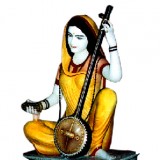

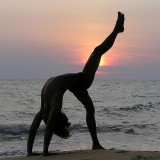



 India has a great heritage of its Kshatriya, its martial, military, aristocratic or princely class, just as most of the world had until recent times. It is among these traditional martial arts that we can find the most diverse and extensive traditions of exercise. Even the Vedas speak of the unity of Brahmin and Kshatriya or spiritual and warrior traditions and the need to honor both.[ Hindu warrior traditions continued through history and developed along with changes of warfare through the centuries.
India has a great heritage of its Kshatriya, its martial, military, aristocratic or princely class, just as most of the world had until recent times. It is among these traditional martial arts that we can find the most diverse and extensive traditions of exercise. Even the Vedas speak of the unity of Brahmin and Kshatriya or spiritual and warrior traditions and the need to honor both.[ Hindu warrior traditions continued through history and developed along with changes of warfare through the centuries.












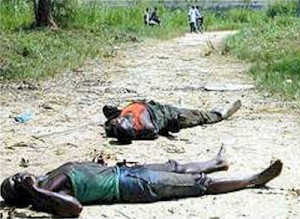
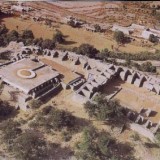

 The beginning of the no-rules Vajramushti match – complete with ivory-carved knuckledusters worn on the right hand of each combatant.
The beginning of the no-rules Vajramushti match – complete with ivory-carved knuckledusters worn on the right hand of each combatant. Vajramushti wrestling techniques included working from the bottom position – in recent times, Brazilian Jiu Jitsu has brought similar strategies into mainstream focus.
Vajramushti wrestling techniques included working from the bottom position – in recent times, Brazilian Jiu Jitsu has brought similar strategies into mainstream focus. The victor has won the match by locking up his opponents weapon arm – note that the lock applied in this case is almost identical to the ‘Omoplata’ of modern day brazilian Jiu Jitsu.
The victor has won the match by locking up his opponents weapon arm – note that the lock applied in this case is almost identical to the ‘Omoplata’ of modern day brazilian Jiu Jitsu. Here are some examples of the various Vajramushti – the two smaller weapons are used for the sporting aspect, whilst the larger, complete with spiked ends, were used in warfare.
Here are some examples of the various Vajramushti – the two smaller weapons are used for the sporting aspect, whilst the larger, complete with spiked ends, were used in warfare. The author in the mid 1980’s,alongside renowned Jyesthimalla wrestler, Shri Sitaram, wearing the Vajramushti.
The author in the mid 1980’s,alongside renowned Jyesthimalla wrestler, Shri Sitaram, wearing the Vajramushti. The author with another Vajramushti wrestler, just prior to a training session in a renowned Jyesthimalla Akhada.
The author with another Vajramushti wrestler, just prior to a training session in a renowned Jyesthimalla Akhada. The 1st page of the Mallapurana text preserved at the Oriental Research Institute in Poona.
The 1st page of the Mallapurana text preserved at the Oriental Research Institute in Poona.
